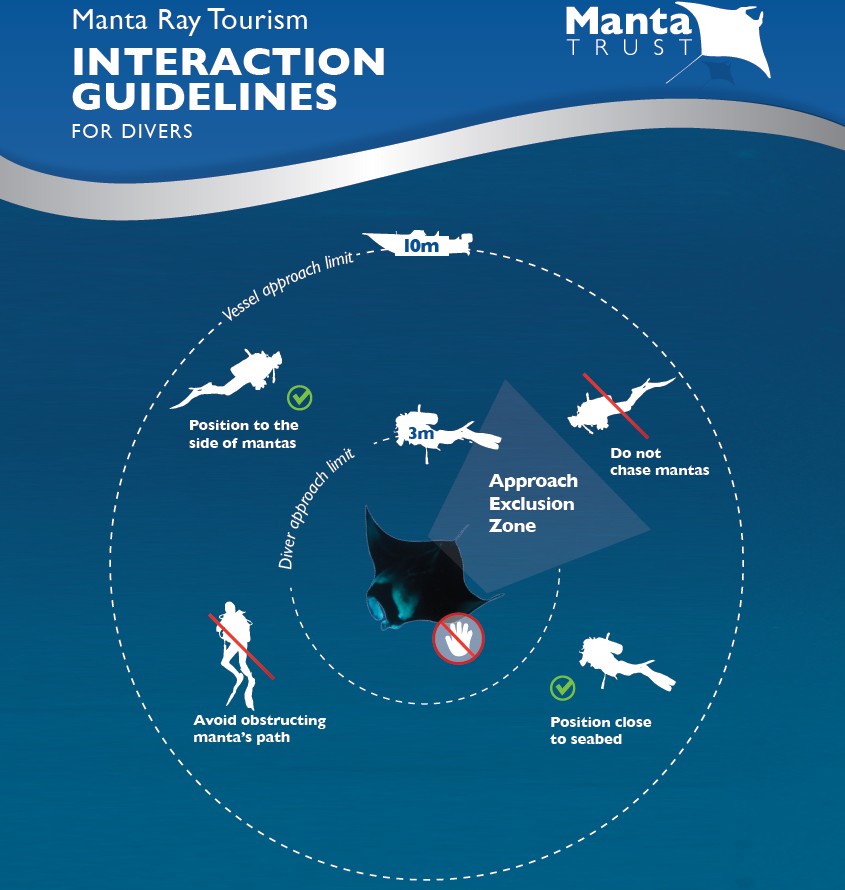Seeing large pelagic animals, such as whale sharks or manta rays, is on every diver’s bucket list. Sometimes, when divers see these amazing creatures for the first time, they’ll become lost in the moment, over-excited or distracted and forget some of the key safety aspects of diving, both for themselves and the animals. One of the most important diving fundamentals to remember is to keep your cool.
The following tips will help you have a safe dive experience while also ensuring that marine life doesn’t feel stressed, threatened or become injured. For the purposes of this mini-guide, we’ll concentrate on manta rays, although the same general rules apply for whale sharks and the like.
Now, picture yourself with in a dive group of about five members, swimming along the reef or ridge near a cleaning station. Your dive guide taps his tank to get your attention and, as you turn and look into the blue, a manta ray — 12 feet (4 m) from wingtip to wingtip — is circling in the ocean a few feet away from the reef. Magical.
What do you do next?
Stay calm!
Novice divers tend to become very excited during their first manta-ray encounter. Your heart rate and breathing rate may increase and, as a result, the heavier breathing can interfere with your buoyancy, causing you to rise in the water column toward the surface. Relax, and try to maintain your normal breathing rate.
Where’s my dive guide?
Once you’ve spotted the manta ray and relaxed, look around to find your dive guide. He or she may have further instructions for you, or be directing you to a safe location from which to view the animal. You don’t want to become entangled with another dive group or separated by drifting off in a current.
Where’s my buddy?
Regardless of whether a manta ray is circling, buddy separation is buddy separation. If you can’t see (and stay reasonably close to) your buddy, it’s time to search for a minute and, if you still don’t find each other, abort the dive.
How much gas do I have?
Along with the excitement and increased breathing rate, divers may find they start to consume their gas more quickly. Once you’ve seen the ray and found your dive leader and buddy, be sure to check your SPG. It’s easy to become distracted by what’s going on. You do not want to end up in a low-on-air situation. If possible, let your dive buddy and divemaster know how much air you’ve got left. Stick to your plan.
How much time do I have?
As beautiful as manta rays are, they can’t change the laws of physics. After you’ve checked in with your dive guide and buddy, check your dive computer. If you’re nearing your no-stop/no-deco limit, shallow up slightly or, if necessary, end the dive and begin your safety stop. As a rule of thumb, a divemaster wants to know when you’re five minutes from your limit. That guideline still applies.
Interact responsibly
Never, ever chase, harass, or touch a manta (or other marine life) in any way for the following reasons:
** Manta rays have perfectly evolved and adapted to their underwater world over millions of years. Rays will often quickly move through the water column — up and down from depth to shallows and back again. As divers, we can’t do that without consequences. Pick a stable visual reference, such as your dive leader or the reef wall, and maintain your depth. Check your depth gauge regularly.
** If you chase the manta ray — furiously finning after it while clutching your camera — there’s a good chance that you’ll either become separated from the rest of your group or scare the animal away, making you the least popular person on the dive boat when you surface. Don’t be that diver. Relax. Follow your guide’s instructions. An inquisitive manta ray may circle around groups of divers for extended periods of time, as long as all the divers remain calm and behave themselves.
** Look but don’t touch. The manta has a protective layer of mucus. Touching them is not dangerous to you, but is quite dangerous to the animal. Mantas are vulnerable to disease and problems with parasites and, if touched, they’re likely to develop various types of lesions or potentially much worse. This has happened historically when divers have broken this rule. Respect the animal and, however tempting, resist the temptation to touch or stroke it.
It’s a privilege to dive with these stunning creatures. Follow these tips for a memorable, and safe, interaction. For more information or to get involved in manta conservation, see the Manta Trust website.


